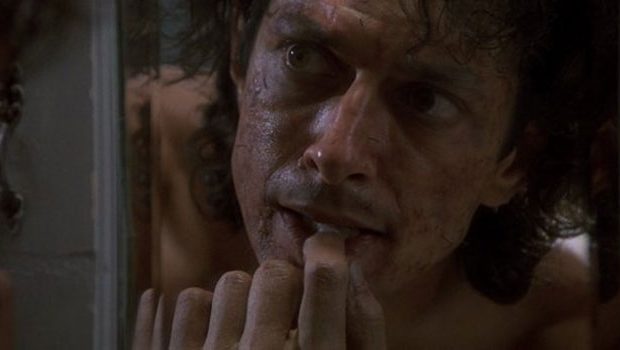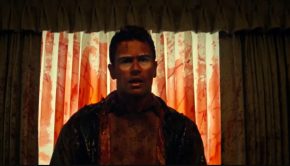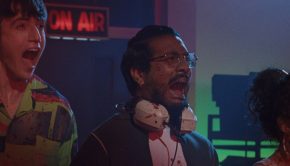Cronenberg Collection DVD Review
Summary: A fascinating look at the origins of a singular voice in horror movie making.
4
Body Horror
David Cronenberg has spent the past forty years carving a distinctive niche in filmmaking. His earliest commercial films display the obsessions that have followed him throughout his career – sex, infection and death, body transformation and body horror, physical and psychological alienation.
This set contains films from Cronenberg’s early period. While he had made two movies in the late 60s, Shivers (1975) was his first mainstream movie that still resonates. Working with producer Ivan Reitman (Ghostbusters) and a passle of Canadian government grant money, they crafted what is now regarded as a cult classic. While Shivers mirrored the 70s obsession with paranoia and conspiracy, the themes behind Shivers were so malleable as to have encompassed the AIDS crisis of the 80s, and back around again to today’s paranoia.
Sex, disease, infection and paranoia are all Cronenbergian trademarks that come to the fore in Shivers. We open with an older man, Doctor Emil Hobbes seemingly about to rape a teenage girl. This soon morphs into something more bizarre. Hobbes strangles the girl, which Cronenberg captures with chilling indifference. Hobbes then tears away the girl’s shirt, cuts open her stomach, pours acid into the wound, then cuts his own throat. And then events really go downhill.
Hobbes is obsessed with the idea (and one wonders if it isn’t also Cronenberg’s as well) that humanity has strayed too far from its nature. To ‘remedy’ this, he creates a parasite that strips man of his pretensions, leaving behind the naked core of his animal nature. Soon, the parasite, and the infection it brings, has spread throughout the complex, infecting men, women and children. At the end, we see the deranged inhabitants on the march towards the nearby city, leaving us with the knowledge that humanity’s future stands on a knife-edge.
Shivers isn’t a very good movie. The acting is basic, and that’s being charitable. The lead character, Dr Roger St Luc, is played by Paul Hampton in so laidback a performance he is almost catatonic. But, it is the movies themes that animate Cronenberg, with the actors pieces to be moved around. That said, it is an early film, with Cronenberg coming to grips with matching his themes with the visual elements. Certainly, there is no doubting that a particular vision is crystallising as we watch the Shivers unfold.
In many ways, Rabid, Cronenberg’s follow up movie, is Shivers done right. It’s still a little amateur, the acting has a way to go, but the scope has expanded away from an isolated location to a larger city. Like its predecessor, the catalyst for Rabid is experimentation gone wrong. Rabid stars famous porn actress Marilyn Chambers (Behind the Green Door – a movie that rivalled Deep Throat for notoriety) as Rose, a young woman involved in a terrible motorbike accident. She is attended to by two plastic surgeons who use an experimental treatment for her wounds. On the surface, this treatment works, but deep within her, something terrible is growing.
In a lot of ways, Rabid is a lo-fi vampire story with an overt sexual element. Again, an infection is spread as Rose’s mutated body requires blood to sustain itself. With clever shorthand, namely radio and news broadcasts, Cronenberg demonstrates the rapid spread and reaction to the infection. Chambers, while clearly lacking in range, does well enough in a role that requires conviction and confusion. Like Shivers, which had a great deal of nudity, Cronenberg isn’t shy in having Chambers undress. While there are high-minded concepts running through the movie, Cronenberg isn’t quite yet willing to fully turn his back on its pulpish elements. The ending is justly famous, and points again to Cronenberg’s nihilistic ethos – we all think we’re the centre of something important, but really, we’re just a hunk of walking meat waiting to be disposed off-camera.
Shivers and Rabid, both written by Cronenberg most fully reflect his interests. The third movie in this set, The Dead Zone, was not written by him. Famously, the novel is by Stephen King, and Jeffrey Boam (Innerspace, The Lost Boys, Lethal Weapon 2) wrote the screenplay. However, despite this, Cronenberg once again brings his trademark dispassion to the filmmaking process.
The Dead Zone opens with teacher Johnny Smith (Christopher Walken, in one of his most mannered performances – check out his overwrought limp later in the movie) reading the last stanza to Edgar Allan Poe’s The Raven, a lament for love lost. Life is good – he’s good at a job he enjoys, and is very much in love with fellow teacher Sarah (Brooke Adams). A terrible car accident cuts short that happiness, and short circuits his life. Awakening from a coma five years later, Johnny finds himself with the ability to tell the future.
A trademark of King’s writing is his sentimentality, as is the love of small towns and the folk populating them. All those elements are in the movie, but Cronenberg turns them on their heads. Sentimentality means nothing when the main character loses almost everything in one terrible accident. He loses his job, his health, his girlfriend, a chance at a family and just after he awakes, his mother dies. The small town that Johnny moves back to after he returns from hospital is stalked by a serial killer, who Johnny helps identify. And Martin Sheen’s character, the politician Stillson, moves through a small town landscape with remarkable cynical ease, convincing the gullible locals with fake charm and a glib tongue that he has the answers to their problems.
Away from the low budgets of his earlier movies, Cronenberg adapts surprisingly well to the expectations of a larger budget. The same alienation is there – Smith’s gift is really a curse and until he decides to make positive use of it, it drives him into seclusion. The atmosphere is, literally chilly, given the winter setting, and even emotions displayed between Johnny and Sarah are at a remove. Taking all that into account, and the fact that The Dead Zone is a sidestep for Cronenberg and not further mining of his obsessions, it is a surprisingly affecting movie and one that rewards closer viewing.
All up, watching these three movies gives something of an overview of Cronenberg’s early career. The jump in quality between Shivers/Rabid and The Dead Zone is marked, but it goes to show that despite the limitations of the low budget movies at the beginning of his career, talent will always out as displayed in The Dead Zone.
A note on the extras. Each of the movies is well represented with behind the scenes footage and photographs. There are interviews with some of the actors involved, particularly The Dead Zone, and there is a very good interview with Douglas E Winter about Stephen King. Cronenberg is represented in archival interviews from the 90s and early 00s and presents a more approachable figure than the chilly manipulator one would expect from watching his movies.
DVD Details
Director – David Cronenberg
Actors – Paul Hampton, Joe Silver, Marilyn Chambers, Frank Moore, Christopher Walken, Brooke Adams, Tom Skerritt, Martin Sheen
Film Genre – Horror
Label – Via Vision Entertainment
Audio – English (Dolby Digital 1.0)
Running Time – 305
Aspect Ratio – 1.78:1
Region Coding – 4
TV Standard – NTSC
Rating – R18+
Screen Format – NTSC
Year of Release – 1975
Primary Format – Movies/TV – DVD







